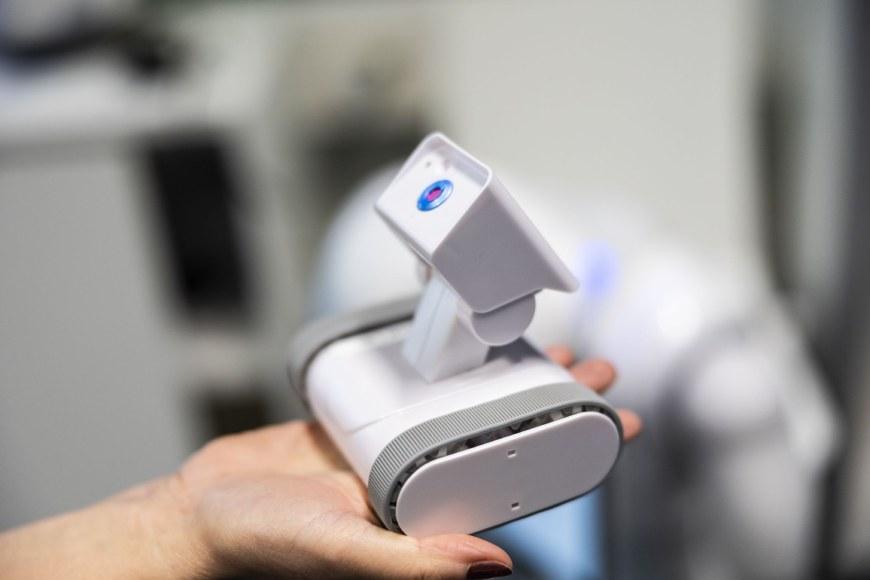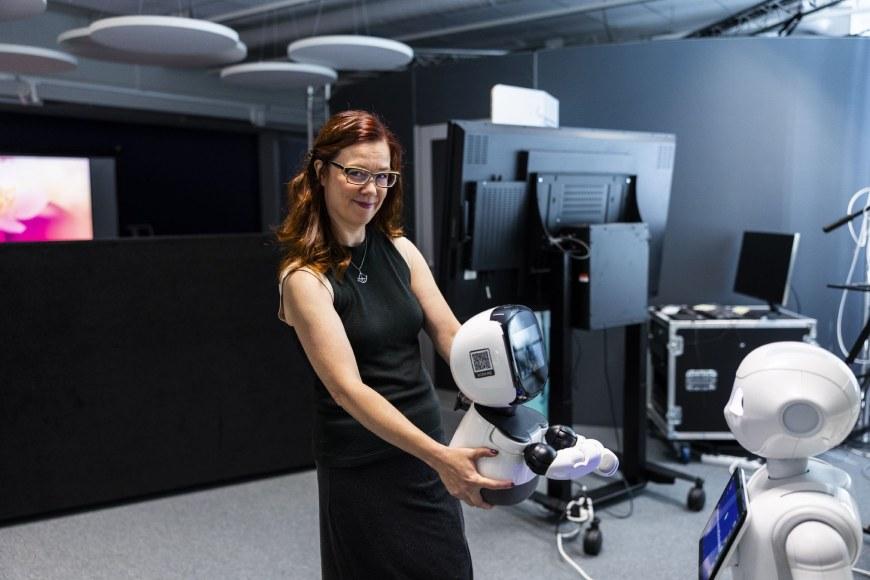Care robotics helps, but does not replace a human being

This article was originally published in Unit, the magazine of Tampere Universities.
The word care robotics easily conjures up an image of a human-like robot lifting a patient out of a hospital bed, feeding, and chatting. It can also raise concerns: can robots replace human interaction?
Experts say no. Instead of human-like robots, care robotics means more technical aids with interactive elements to support human work. At best, care robotics technology will make care workers’ jobs easier while making patients feel safer and activating them.
Taru Manner, a lecturer in nursing at Tampere University of Applied Sciences, explains that technological aids used in hospitals and home care are two different things. In hospitals, technology is used to monitor and treat symptoms and diseases. In home care, tools and apps are used daily to make everyday life easier.
The use of video-mediated remote home care is advanced in the Pirkanmaa region. The customer gets a tablet-like device at home, which they do not need to know how to switch on themselves. Home care can connect to the customer’s device and the care worker can talk to and guide the customer.
Pirkanmaa also has four hundred Evondos pill organiser robots. The medicine doses are dispensed into the device in sachets, and the device alerts when it is time to take the medicine. If the medicine is not taken, home care is notified, and the sachet falls into the robot’s tamper-resistant container.

An exoskeleton vest helps with physical work. A nurse can wear a vest with gas spring technology, which gives them extra strength to lift a patient and maintain an ergonomic posture.
“Power vests are a big trend in Asia. Exoskeletons that can be worn by the patient to give them strength for movement are also on the rise,” says Manner.
Technology can be used to activate people
Using remote access and medication dispensing robots in home care has given care workers more time. Working days have become calmer and care workers can focus on planning their work. The impact is so significant that Manner believes the technology could even ease the nursing shortage.
“We are at a stage where the perception of the whole social and healthcare services sector is changing. Pirkanmaa is well advanced in this respect, and home care providers have made a real difference,” Manner points out.
Technology has also had a positive impact on customers. There is much talk about the passive effect of technology, but for older people it can have the opposite effect.
“From my discussions with home care workers, video-mediated care can support people’s agency when the care worker is not there and cannot do everything for them. I would be more concerned about the passivity of our working age population.” Manner adds.
Manner points out that not everyone in home care needs home visits either. Some people want to be left alone, and visitors coming to the home at different times can be stressful.
Remote access can also extend customer's social relations. Contact with relatives and friends can be made easier, and a video link can be used to attend a gym class or a concert.
Multifunctional robots are being developed
Let’s return to the humanoid and interactive robots mentioned at the beginning of this article. “Such multifunctional robots are still in development in the care sector”, says Tuuli Turja, a social psychology researcher with expertise in care robotics.
“Some doll-like humanoid robots exist and are used for recreational and entertainment purposes. Nao robots can be programmed with personalised exercise programmes. The robot recognises the users and their specific programmes and provides advice on how to do the exercises,” Turja says.
The most familiar interactive care robot is probably the therapeutic soft toy seal robot, used for example in the care of people with dementia and autism. The robot vocalises like a real animal, reacts to changes in light, and learns its name.

Turja was a member of the multidisciplinary ROSE project, which studied care robotics and the values and attitudes associated with it. Originally, the project was to study an interactive, multifunctional Care O´Bot care robot that can communicate and help with daily tasks, for example, by serving food.
However, programming the device proved difficult. The development of Care O´Bot will continue. Eventually the project explored simpler robotics such as customer service robots, a medicine dispensing robot, a hospital TUG logistics robot, and remote presence technology.
“My study focused on how robots are being received at the workplace, and what are care workers’ needs for the new generation of robotic technology,” Turja mentions.
Helping people
The care workers’ message to researchers was that they need robotics and technology to support their work, for example, to move patients and lift other heavy loads. They were less enthusiastic about robotics for patients’ entertainment and recreation.
“With researcher Jaana Parviainen, we divided robotics into "affective" and "effective" categories. Care workers preferred tool-like robotics of the “effective” category that make daily practises easier,” Turja says.
Some care workers feel that care robotics is not in line with the ethical standards of work.
However, according to Turja, affective robotics can have more noble purposes than just entertainment. Stroking a seal robot can increase enjoyment of life for a person with dementia and make them feel meaningful when they are allowed to be a carer. A therapeutic toy can also get an autistic person to talk to the toy about things they do not talk to others about.
Interaction and empathetic, respectful encounters with patients are the core values of the caring profession. Some care workers feel that care robotics is not in line with the ethical standards of their work. However, attitudes towards care robotics have become more positive.
“We conducted the first survey in 2016 and a second in 2020. In the new survey, care robotics was perceived as more in line with the values of the sector. I would perhaps conclude that care workers have realised that it is not a substitute for a human being and human care,” Turja says.
Manner says she has found that the attitude towards care robotics is positive if students are exposed to the technology during their studies and consider it part of their daily practises. There is more scepticism among professionals already working in the sector.
Improved speech recognition
How do experts see the future of care robotics?
Turja does not believe that humanoid multi-robots will be able to handle both medicine dispensing and entertaining patients in the next few years. It is likely that the current technology will evolve, and the evolution could be very mundane.
In the future, an exoskeleton vest may be so thin that it can be worn under clothes. This is the wish of some care workers, as they fear that wearing a vest on top of their clothes will make them look like cyborgs and that this will interfere with their interaction with the patient. In addition to vests powered by gas spring technology, more robotic, motorised wearable technology is being trialled.

Developing speech recognition is also important.
“Patients have different dialects. Increasingly many people speak different languages, and dentures can make speech production difficult,” Turja points out.
Safety from smart homes
Manner says she expects applications that will enrich everyday life especially in remote home care to become available soon.
“It can be an avatar integrated into people’s daily lives via television, or a physical, intelligent little chatbot that keeps people company,” she says.
Manner believes that sensors and technologies embedded in the home will also evolve in the coming years. Homes already have motion-activated lights and smart hobs that turn themselves off. Experiencing everyday technology that makes life easier can also help to reduce preconceptions about care robotics.
Tampere Universities community is closely involved in the research and implementation of care-related technologies. TAMK’s students have access to healthcare technology in the Sote Virtual Lab, and care technology is also part of practical nurses’ teaching in Tampere.
The Universities community is also involved in planning the national coordination model for technology for the ageing conducted by the Finnish Institute for Health and Welfare. The model aims to support welfare regions and municipalities in the use of technology for older people living at home.
“We should now think about the role of universities and higher education institutions in this development and what resources are needed,” Turja says.
Author: Janica Brander








